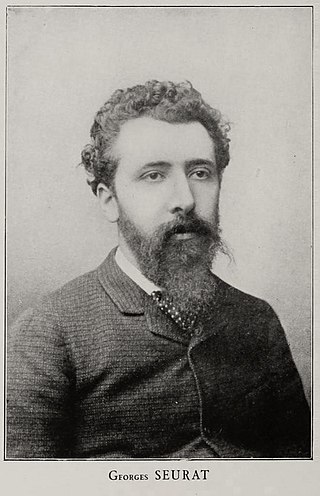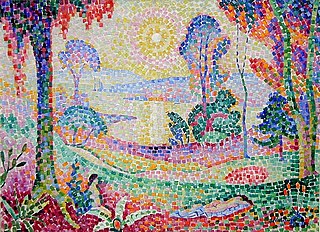
Georges Pierre Seurat was a French post-Impressionist artist. He devised the painting techniques known as chromoluminarism and pointillism and used conté crayon for drawings on paper with a rough surface.

Pointillism is a technique of painting in which small, distinct dots of color are applied in patterns to form an image.

Neo-Impressionism is a term coined by French art critic Félix Fénéon in 1886 to describe an art movement founded by Georges Seurat. Seurat's most renowned masterpiece, A Sunday Afternoon on the Island of La Grande Jatte, marked the beginning of this movement when it first made its appearance at an exhibition of the Société des Artistes Indépendants in Paris. Around this time, the peak of France's modern era emerged and many painters were in search of new methods. Followers of Neo-Impressionism, in particular, were drawn to modern urban scenes as well as landscapes and seashores. Science-based interpretation of lines and colors influenced Neo-Impressionists' characterization of their own contemporary art. The Pointillist and Divisionist techniques are often mentioned in this context, because they were the dominant techniques in the beginning of the Neo-Impressionist movement.

Divisionism, also called chromoluminarism, is the characteristic style in Neo-Impressionist painting defined by the separation of colors into individual dots or patches that interact optically.

Edward Middleton Manigault was a Canadian-born American Modernist painter.

The Red Studio is an oil on canvas painting by French artist Henri Matisse from 1911. It is held in the collection of the Museum of Modern Art, in New York.

Bathers at Asnières is an 1884 oil on canvas painting by French artist Georges Pierre Seurat, the first of his two masterpieces on the monumental scale. The canvas is of a suburban, placid Parisian riverside scene. Isolated figures, with their clothes piled sculpturally on the riverbank, together with trees, austere boundary walls and buildings, and the River Seine are presented in a formal layout. A combination of complex brushstroke techniques and a meticulous application of contemporary color theory bring to the composition a sense of gentle vibrancy and timelessness.

The Hudson–Fulton Celebration from September 25 to October 9, 1909 in New York and New Jersey was an elaborate commemoration of the 300th anniversary of Henry Hudson’s discovery of the Hudson River and the 100th anniversary of Robert Fulton's first successful commercial application of the paddle steamer. The maritime achievements of Hudson and Fulton foreshadowed the importance of the river to New York's progress and identity. Organizers used the event not only to display the success of the two men, but also the status of New York City as a world city and the achievements of its citizens.

A Woman Walking in a Garden is an oil-on-canvas painting by Dutch Post-Impressionist painter, Vincent van Gogh. This painting was created in 1887 during the two years van Gogh lived in the northern suburbs of Paris. There is a woman walking through a lush and green garden dotted with flowers and in the background there is a building concealed behind a thick row of trees. A red paint border along the edge of the canvas frames the scene.This painting is a part of the Riverbank in Clichy Triptych along with Fishing in Spring housed at the Art Institute of Chicago and River Bank in Springtime housed at the Dallas Museum of Art. All three pieces have red borders as to indicate their association to each other in a triptych.

Asnières, now named Asnières-sur-Seine, is the subject and location of paintings that Vincent van Gogh made in 1887. The works, which include parks, restaurants, riverside settings and factories, mark a breakthrough in van Gogh's artistic development. In the Netherlands his work was shaped by great Dutch masters as well as Anton Mauve a Dutch realist painter who was a leading member of the Hague School and a significant early influence on his cousin-in-law van Gogh. In Paris van Gogh was exposed to and influenced by Impressionism, Symbolism, Pointillism, and Japanese woodblock print genres.

Seine (paintings) is the subject and location of paintings that Vincent van Gogh made in 1887. The Seine has been an integral part of Parisian life for centuries for commerce, travel and entertainment. Here van Gogh primarily captures the respite and relief from city life found in nature.

Still life paintings by Vincent van Gogh (Paris) is the subject of many drawings, sketches and paintings by Vincent van Gogh in 1886 and 1887 after he moved to Montmartre in Paris from the Netherlands. While in Paris, Van Gogh transformed the subjects, color and techniques that he used in creating still life paintings.

The Channel of Gravelines, Petit Fort Philippe is a pointillist painting by French artist Georges Seurat, located in the Indianapolis Museum of Art in Indianapolis, Indiana. Painted in 1890, the year before his death, it depicts a harbor in the small French port of Gravelines. Described as "wistful and poetic," it is one of the treasures of the IMA.

The House of the Deaf Woman and the Belfry at Eragny is an 1886 oil painting by French artist Camille Pissarro, located in the Indianapolis Museum of Art, which is in Indianapolis, Indiana. It is a view of Pissarro's neighbor's yard in Eragny, created during his brief period of experimentation with pointillism.

The Lagoon of Saint Mark, Venice is an oil on canvas painting by Paul Signac. This painting focuses on a seascape image which became a common theme late in Signac's life.

Coucher de soleil no. 1 is an oil painting created circa 1906 by the French artist and theorist Jean Metzinger (1883–1956). Coucher de soleil no. 1 is a work executed in a mosaic-like Divisionist style with a Fauve palette. The reverberating image of the Sun in Metzinger's painting is an homage to the decomposition of spectral light at the core of Neo-Impressionist color theory.

Le Chahut is a Neo-Impressionist painting by Georges Seurat, dated 1889–90. It was first exhibited at the 1890 Salon de la Société des Artistes Indépendants in Paris. Chahut became a target of art critics, and was widely discussed among Symbolist critics.

Imperial Fritillaries in a Copper Vase is an oil painting on canvas created by the post-impressionist painter Vincent van Gogh in Paris, 1887. The painting is now part of the collection of the Musée d'Orsay in Paris, France. This work was made at a time of the life of Van Gogh when he first encountered influences from Impressionists and became aware of light and color, implementing it in his paintings. This painting presages some of his most famous subsequent works, and stands out from other still lifes because of the implementation of mixed techniques and complementary colors.

Maria Sèthe at the Harmonium is an oil-on-canvas painting by the Belgian neo-impressionist painter Théo van Rysselberghe. It depicts a woman with blonde, worn-up hair and a purple dress, seen in profile gazing toward the left. The sitter was Maria Sèthe, who belonged to an affluent musical family with an interest in the arts. In the painting, she is seated at a harmonium but is not playing it.

Sailboats and Estuary is an oil-on-canvas painting by Belgian srtist Théo van Rysselberghe. Painted around 1887, it shows a coastal landscape elaborated in a Pointillist technique. Van Rysselberghe probably adopted the Pointillist manner after befriending Signac; however, the use of color in Sailboats and Esuary is nonetheless far more realistic than in paintings by Signac and other Neo-Impressionists, and reveals a tendency towards naturalism. The artwork has been in the collection of the Musée d'Orsay in Paris since 1982, on loan from the Louvre.



















